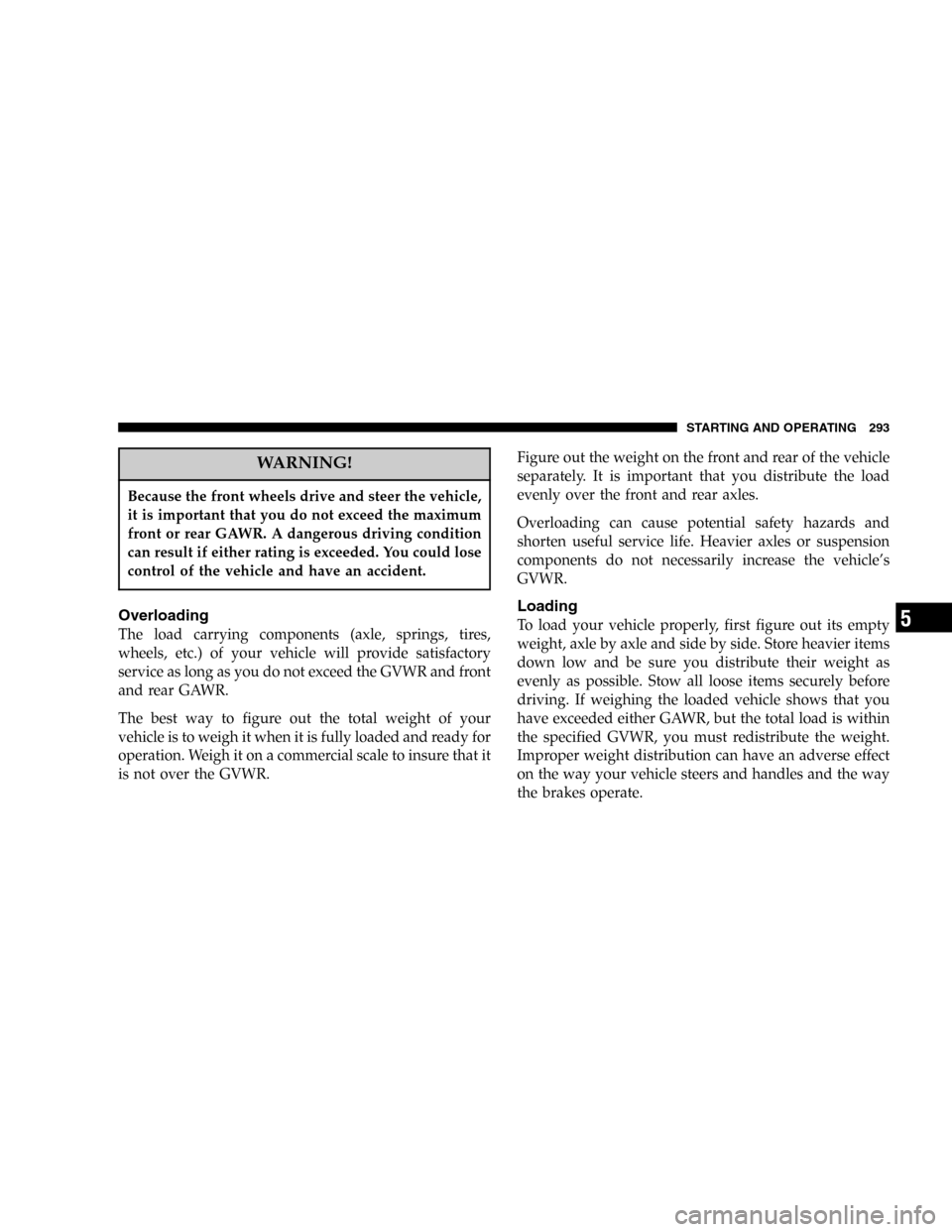Page 293 of 420

WARNING!
Because the front wheels drive and steer the vehicle,
it is important that you do not exceed the maximum
front or rear GAWR. A dangerous driving condition
can result if either rating is exceeded. You could lose
control of the vehicle and have an accident.
Overloading
The load carrying components (axle, springs, tires,
wheels, etc.) of your vehicle will provide satisfactory
service as long as you do not exceed the GVWR and front
and rear GAWR.
The best way to figure out the total weight of your
vehicle is to weigh it when it is fully loaded and ready for
operation. Weigh it on a commercial scale to insure that it
is not over the GVWR.Figure out the weight on the front and rear of the vehicle
separately. It is important that you distribute the load
evenly over the front and rear axles.
Overloading can cause potential safety hazards and
shorten useful service life. Heavier axles or suspension
components do not necessarily increase the vehicle’s
GVWR.
Loading
To load your vehicle properly, first figure out its empty
weight, axle by axle and side by side. Store heavier items
down low and be sure you distribute their weight as
evenly as possible. Stow all loose items securely before
driving. If weighing the loaded vehicle shows that you
have exceeded either GAWR, but the total load is within
the specified GVWR, you must redistribute the weight.
Improper weight distribution can have an adverse effect
on the way your vehicle steers and handles and the way
the brakes operate.
STARTING AND OPERATING 293
5
Page 294 of 420
A loaded vehicle is shown in the illustration. Note that
neither the GVWR or the GAWR capacities have been
exceeded.Example Only Front
AxleRear Axle
Empty Weight 2538 lbs
(1151 kg)2076 lbs
(942 kg )
Load (Including driver, pass-
sengers and cargo)223 lbs
(101 kg)890 lbs
(404 kg)
Total 2762 lbs
(1253 kg)2968 lbs
(1346 kg)
GAWR 2826 lbs
(1282 kg)3035 lbs
(1377 kg)
TRAILER TOWING
In this section you will find safety tips and information
on limits to the type of towing you can reasonably do
with your vehicle. Before towing a trailer carefully re-
view this information to tow your load as efficiently and
safely as possible.
294 STARTING AND OPERATING
Page 295 of 420

To maintain warranty coverage, follow the requirements
and recommendations in this manual concerning ve-
hicles used for trailer towing.
Perform maintenance services as prescribed in the main-
tenance schedules manual. When your vehicle is used for
trailer towing, never exceed the gross axle weight rating
(GAWR) by the addition of:
•The tongue weight of the trailer.
•The weight of any other type of cargo or equipment
put in or on your vehicle.
•Remember that everything put in or on the trailer adds
to the load on your vehicle.
Tongue weight must be equal to at least 10% of Gross
Trailer Weight (GTW), but no more than 15% of GTW.
Towing Requirements
•
The maximum frontal area of the trailer cannot exceed
40 square feet (3.72 square meters).
•The trailer tongue load must be considered as part of
the combined weight of occupants and cargo, and
should never exceed the weight referenced on the Tire
and Loading Information placard. Refer to the Tire–
Safety Information Section in this manual.
•The“D”range can be selected when towing. However,
if frequent shifting occurs while in this range, the“3”
range must be selected.
NOTE:Using the“3”range while operating the vehicle
under heavy operating conditions will improve perfor-
mance and extend transmission life by reducing exces-
sive shifting and heat build up.
STARTING AND OPERATING 295
5
Page 296 of 420

•Do not attempt to tow a trailer while using a compact
spare tire.
•Whenever you pull a trailer, regardless of the trailer
size, stop lights and turn signals on the trailer are
recommended for motoring safety.
•The automatic transmission fluid and filter should be
changed if you REGULARLY tow a trailer for more
than 45 minutes of continuous operation. See Schedule
“B”in section 8 of this manual for transmission fluid
change intervals.
NOTE:
•Check the automatic transmission fluid level before
towing. Fluid discoloration, or a burnt odor, shows the
need for a transmission fluid and filter change.
•For vehicles equipped with Autostick. By using the
Autostick modes, and selecting a specific gear range,
frequent shifting can be avoided. The highest gear
range should be selected that allows for adequate
performance. For example, choose“4”if the desired
speed can be maintained. Choose“3”or“2”if needed
to maintain the desired speed.
•Extended driving at high RPM should be avoided to
prevent excess heat generation. A reduction in vehicle
speed may be required to avoid extended driving at
high RPM. Return to a higher gear range or vehicle
speed when road conditions and RPM level allows.
296 STARTING AND OPERATING
Page 298 of 420
WARNING!
Connecting trailer brakes to your vehicle’s hydraulic
brake lines can overload your brake system and
cause it to fail. You might not have brakes when you
need them and could have an accident.
RECREATIONAL TOWING (BEHIND
MOTORHOME, ETC.)
TOWING THIS VEHICLE BEHIND ANOTHER
VEHICLE (Flat towing with all four wheels on the
ground)
Recreational towing for this vehicle is not recommended.
NOTE:If the vehicle requires towing make sure all four
wheels are off the ground.
298 STARTING AND OPERATING
Page 299 of 420
WHAT TO DO IN EMERGENCIES
CONTENTS
�Hazard Warning Flasher..................300
�If Your Engine Overheats.................301
�Jacking And Tire Changing................302
▫Jack Location........................303
▫Spare Tire Stowage....................304
▫Preparations For Jacking................305
▫Jacking Instructions....................306
�Jump-Starting Procedures If Battery Is Low....309
�Driving On Slippery Surfaces..............311
▫Acceleration.........................311▫Traction............................311
�Freeing A Stuck Vehicle..................312
�Towing A Disabled Vehicle................313
▫With Ignition Key.....................313
▫Without The Ignition Key...............314
▫Towing This Vehicle Behind Another Vehicle
(Flat Towing With All Four Wheels On The
Ground)............................314
▫Towing This Vehicle Behind Another Vehicle
With A Tow Dolley....................315
6
Page 303 of 420
Jack Location
Five Passenger Seating
The jack and jack-handle are stowed in the rear storage
bin located behind the second row bench seat. Pull up on
the storage bin cover to access the jack and jack tools.Remove the scissors jack and jack handle by rotating the
small wing nut to the left.
Jack Location
Jack Wing Nut
WHAT TO DO IN EMERGENCIES 303
6
Page 304 of 420
Six Passenger Seating
The jack and jack-handle are stowed in the rear storage
bin located in the rear cargo floor. Pull up on the storage
bin cover and liner to access the jack and jack tools.
Spare Tire Stowage
Five Passenger Seating
The spare tire is stowed under the rear of the vehicle by
means of a cable winch mechanism. To remove or stow
the spare, use the jack handle to rotate the“spare tire
drive”nut. The nut is located under the plastic cover at
the center rear of the cargo floor area, just inside the
liftgate opening.
Six Passenger Seating
The spare tire is stowed under the rear of the vehicle by
means of a cable winch mechanism. To remove or stow
the spare, use the jack handle to rotate the“spare tire
drive”nut. The nut is located under the trim cover at the
center of the rear storage bin in the rear cargo floor.
Jack Location
304 WHAT TO DO IN EMERGENCIES